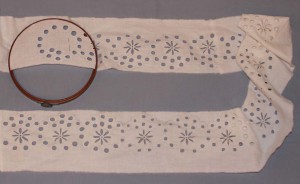Guipure Trimming
January 11th, 2011
Some women indulge themselves with expensive perfumes, dark chocolate, or spa visits. I subscribe to Accessible Archives. For a modest yearly fee, I can search every issue of Godey’s Lady’s Book ever published, not to mention lots of other great historical sources. The only down side is that since I find whatever I want immediately, I rarely bother to browse. And browsing is the best way to come across what you aren’t looking for.
Peterson’s Magazine, a Godey’s copycat, is searchable only through a very expensive academic database. So I read back issues, bound by the year, thanks to Google Books. I was browsing Peterson’s 1855 for chemise patterns when this showed up:

Given my recent obsession with petticoat trimming, I earmarked it for a trial run. And last week, I pulled out my crochet hook and a skein of cotton thread and whipped up 4 repeats of the pattern. Since the way thread and needle sizes are designated have changed since the 1850s, it’s always a bit of a guessing game to see which you should use. I had number 16 cotton on hand, and a size 10 (1.3 mm) crochet hook. The hook was a little small for the thread, but the next one up in my kit was far too big.
I really like the way this pattern looks. Though I would prefer a finer thread. Probably a great deal finer. Like most crochet edgings, it starts with a chain as long as you will require. There are only 7 rows, but at least two are quite involved. I think it would be slow going to trim a full petticoat, though not nearly so slow as Broderie Anglaise. And the effect would likely be stunning.
I had to fiddle with the pattern a little to make it work; thank heavens for the picture, which helped with intuitive leaps when the written directions became unclear. Some of the changes I made might not have been necessary though if I’d been using finer thread…and the end result would likely have been neater.
Oh, and if you are afflicted with curiosity, like me and the cat, real guipure is a heavy needlepoint lace in which the patterns are connected by thread ties or mesh. True lace, which was phenomenally expensive in the mid-19th century, was often imitated by crochet. One of the most noted examples of this is the legendary Irish crochet: “faux” laces created with great dexterity and sold by women to support their families during the Famine. Incidentally, by the end of the 19th century, exquisite Irish crochet was valued on its own merits, rather than its ability to mimic more expensive laces.
Nearly Halfway
December 18th, 2010
Last March I began a truly monumental project: to whit, a hand-sewn, tucked, embroidered petticoat based on an 1854 Practical Dress Instructor pattern from Godey’s Lady’s Book. The skirt, comprising 3 panels of 45 inch “calico” (modern cotton muslin) was finished in relatively short order, including 6 hand-sewn tucks and a 2 inch wide insertion of white-on-white embroidered morning glories going all the way around the bottom. I’ll post pictures once I dig it out of my sewing closet, where it has been peacefully reposing for some time now.
Then it was on to the frill in Broderie Anglaise. And that’s where I’ve been stuck for the past 6 months. Cutting and stitching, cutting and stitching, all with a single thread of embroidery floss. I’m finally nearing the halfway point on the cut-work. When all 135 inches are finally complete, I’ll go back over it again to buttonhole the scalloped edge.
« Newer Posts

